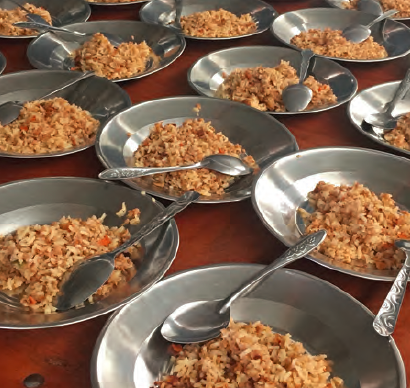The nutrition-sensitive potential of agricultural programmes in the context of school feeding: Lessons from Haiti
 Summary of Field Exchange 51 article by Nathan Mallonee, Jason Streubel, Manassee Mersilus and Grace Heymsfield
Summary of Field Exchange 51 article by Nathan Mallonee, Jason Streubel, Manassee Mersilus and Grace Heymsfield
Haiti is the poorest country in the western hemisphere, with 61.7% of the population living below the international poverty line of US $1.25 per day; 23.4% of Haitian children are stunted and 10.6% are wasted. Haiti suffered from high levels of undernutrition and food insecurity prior to the devastating earthquake in 2010. Since this time, although areas affected by the earthquake have seen improved food security, a third of the population remains food-insecure.
Since 2007, Convoy of Hope (COH) has implemented a school feeding programme (SchFP), largely in primary schools in Haiti. The project started supplying 6,000 children with a supplementary meal and was primarily implemented through COH’s partner, Mission of Hope (MOH). Community members prepared and served hot meals to students each day of the school year. During 2013 and 2014, 425,000 meals were served weekly.
Each child received 11 grammes of protein and up to 100% of the recommended daily intake of vitamins and minerals such as vitamin A, iron, zinc, and vitamin B12. Servings were often supplemented by schools with locally procured fruits and vegetables. Some schools also received nutrition and hygiene training led by a Ministry of Health community health nurse on topics such as handwashing, cholera prevention and dental hygiene.
As the project scaled up, it led to an agricultural extension programme designed to boost local production to enable food supply to the SchFP and increase farmer income. Activities included the provision of full-time access to a trained Haitian agronomist, monthly educational workshops and provision of seeds distributed to each farmer for two or three different crops. Each individual agreed to save 10% of their harvest as seed for subsequent seasons and to donate 10% of the initial harvest back to the SchFP.
Pre and post-season surveys revealed that from 2012 to 2014, there was a ( 245% increase in black bean, sorghum (266%) and pigeon pea (121%) yields. This translated to an average increase in household income from US $2 per day to US $7. Interviews and on-site tests showed improved soil productivity and fertility, an increase in organic matter and an increase in water-holding capacity. Importantly, the project was also perceived locally to be a success.
Community leaders approached COH in early 2015 and suggested that the agriculture project move on to other communities. Key to the success of the project was the use of church networks to implement the training, which increased the trust of farmers.
Project challenges have included the difficulties in the adoption of new farming techniques among farmers before seeing the potential for increased profits; collecting reliable anthropometric data which required adequately training and motivating staff; and ensuring that the agriculture extension projects are more nutrition-sensitive by linking farming skills to school or community gardens and looking for opportunities for increased hygienepromotion activities. Almost half of the agriculture participants are women, which provides COH with the ability to directly reach mothers with nutrition and hygiene education in the classroom or in field agriculture training sessions.

